|
Location: Nr
Oldcastle, Co Meath, Ireland (N 585
775). |
Grid Reference:
53� 44' 37.77" N, 7� 6' 47.66" W. |
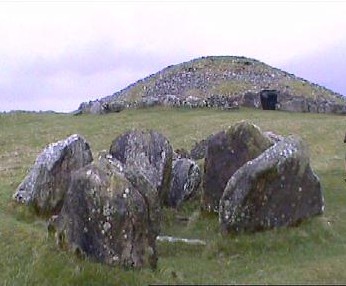  Loughcrew Complex:
(Passage Mounds).
Loughcrew Complex:
(Passage Mounds).
The cairns at Loughcrew form the largest complex of passage graves in
Ireland. The engravings are on-par with those at the Boyne Valley, and
the orientations of the mounds shows a clearly associated with
significant moments of the solar year.
Loughcrew stands out from its surroundings
through the three peaks, known as Cairnbane West, Cairnbane East and
Patrickstown. Scattered over these peaks and the slopes of Loughcrew are
30 megalithic cairns in various states of decay.
(Map of Site:
How to get there)
|
Loughcrew:
('Sliabh na Caillighe', Mountain of the 'Hag'/'Witch') |
Loughcrew; from 'Loch
Craobh', (The Lake of
Branches), is a collection of passage mounds spread across four
adjoining hill-tops. Unfortunately, it seems as though much of the
site was lost, as there were probably once as many as 50 passage
mounds on the site (1).
The site is well worth visiting as if not just for the views.
Although the main mound is closed, there are still plenty of open
mounds to explore, with engravings of spirals etc on nearly every
one.

Cairbane West:
Fifteen remaining monuments.
Cairn
L, An unusual chambered cairn, with seven recesses, three on each
side and one at the end. The
right-back recess, as is usual with these monuments, is much larger
than the others. It contains a massive stone basin and one of the
finest engravings at Loughcrew (pictures below). The monument was
reconstructed in the 1940's by the Office of Public Works
When
Conwell arrived in 1863 the roof had collapsed and the chamber was
full of rubble. He estimated that the capstone probably stood between
16' and 18' above the floor of the chamber. He made a large number of
finds in Cairn L, including two large stone spheres and several
smaller chalk balls under the large basin in the left recess. These
can be seen in the National Museum of Ireland.
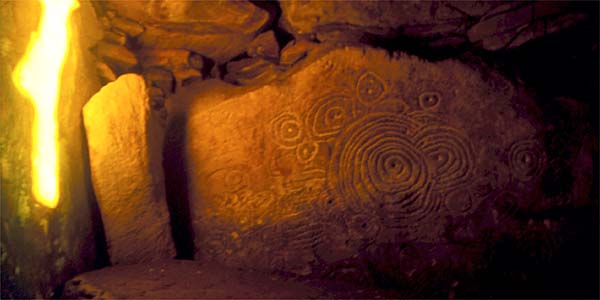
(Photo credits:
http://www.carrowkeel.com/sites/loughcrew/cairnl.html )
Sunlight from the 8th Nov
and 4th Feb cross-days enters the chamber and illuminates the top of a
standing stone inside the chamber (A feature also seen at
Bryn Celli Ddu in Wales)
(Click here for YouTube
video of event:
http://www.youtube.com/watch?v=3SF8k6kCtBs )
Patrickstown: Five remaining but destroyed monuments: Cairns Y,
YB, X, XA, XB.
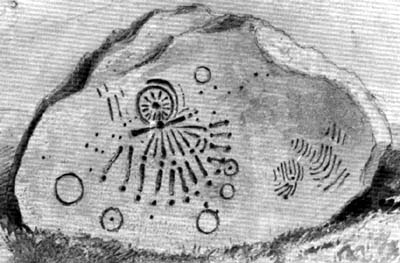
Rayed-circle or 'calendar-stone' from Cairn-X. (similar to that seen at
Knowth: K15).
Cairnbane East:
The eastern hill where as many as 21
sites are said to have been destroyed. The remains of only three can be
seen today,
including one of the largest, and most
prominent monuments of the whole site, Cairn-T.
(Plan of Cairn-T)
Cairn T, One of the largest tombs in the complex is
positioned so as to be at the highest point of the whole complex. similar in
design to Newgrange). Orientated to the Spring Equinox, it possesses a total
of 19 decorated orthostats, 2 decorated sill-stones, 8 decorated roof-stones
and 1 decorated kerbstone (Shee Twohig 1981, 214). It is locked but
accessible by obtaining a key from the tea-house at Loughcrew gardens.
The monument is complete except for its capstone, which has
been replaced with a grill. The mound was also covered with a mantle of
quartz, which was mentioned by early visitors but no longer exists today.
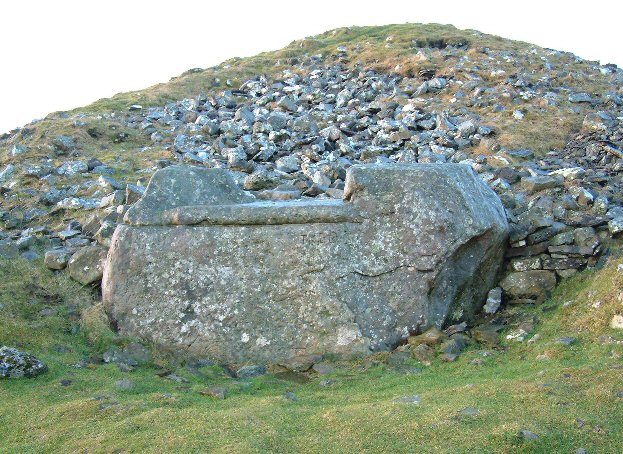
'Ollamh Fodhla's Seat' - The 'Hag's chair':
(Photo credits: Knowth.com)
The huge stone called the 'Hags/witches' chair is on the
northern side of the mound and therefore faces the direction of the pole star.
The inside chambers of the mound are separated by
'sill-stones' in the ground, a design feature also seen at several of the
mounds at Carrowkeel. It is a cruciform
chamber, with a corbelled roof and some of the most beautiful examples of
Neolithic art in Ireland. During the Vernal and Autumn Equinox at dawn the
sunlight enters the chamber and illuminate the inside of the tomb.
Chronology -
There is as yet, no radio-carbon dating of Loughcrew, but it has been
observed that the rock engraving techniques appear to be more primitive than
at the Boyne Valley complex, suggesting an earlier date.
Archaeo-astronomy:
Loughcrew is inter-visible with the Boyne-Valley complex, which is also
marked by several large, engraved passage-mounds, all of which show an
astronomical preference in their orientations.
Martin Brennan's excellent research concerning the orientation of numerous
Irish sites, revealed the importance of astronomy to the builders and a
connection between sites tying the Irish landscape together. It seems
that all the passage mounds had orientations to important parts of the solar
and lunar cycles, and he suggested that they worked together to foretell the
coming equinoxes, solstices, quarter-days and lunar maximum and minimum
standstills.
(1)
Both Cairn's L and T demonstrate clear solar orientations.
Local Tradition: The name associates the hills with
the 'witch or hag', both female and said by some to be a memory of the
earth-mother goddess.
Gallery of Images:
.jpg)
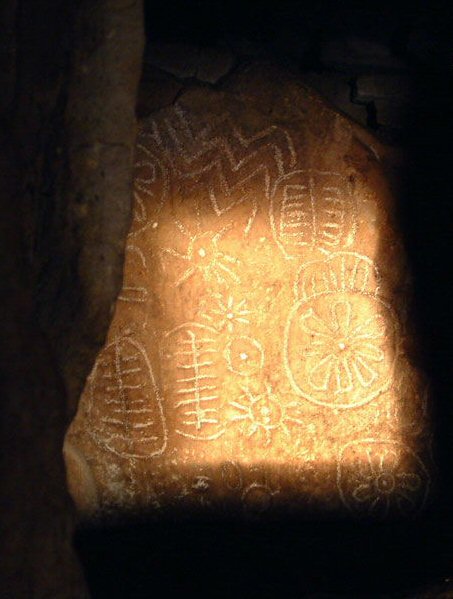
Solar wheels, circles and cup-marks on stone L1, (Left),
and the
'Equinox-stone' C8, at the rear of the west recess (Right).
(Other
Prehistoric Irish Sites)
|